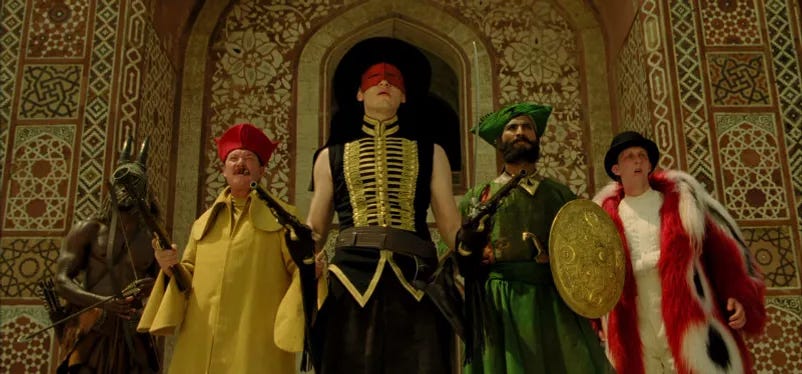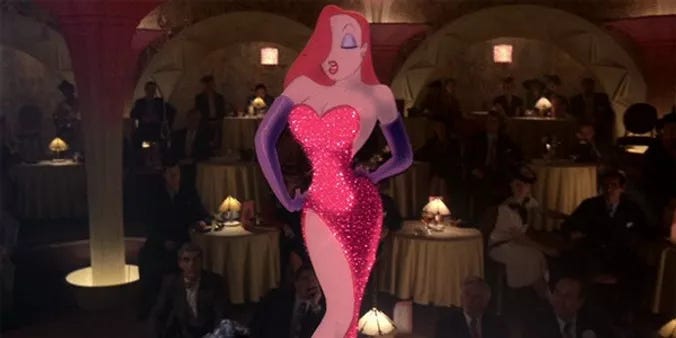Anyone that has chatted with me for at least 30 minutes, would know movies truly obsess me. especially those that do more than merely entertain.
movies that get under your skin are not easy to find though. they are a strange mix of captivating storytelling, convincing performances, and small details, such as an impeccable costume design or a moving soundtrack.
here are some fashion choices in film that have inspired me throughout the years and stayed with me ever since.
1. The Fall (2006)
A crossover between fantasy and reality, the fall excels at transporting you to a sleek looking scenario, inspired by oriental cultures and painting-worthy composition. the five heroes, showing in the image above, are all dressed up by Japanese art director and costume designer Eiko Ishioka. the fall summarises some of her best work, balancing asymmetric lines and modern cuts with more traditional uniform designs, as it happens with Lee Pace's (front actor) sleeveless military jacket and red mask. She also contributed to one of the most iconic costume designs in film, when she joined Coppola in Bram Stoker' Dracula in 1992, where she applied a similar concept to victorian outfits.
2. Wild at Heart (1990)
As with any David Lynch movie, "Wild at Heart" is full of symbolism, and clothing is one of the places this manifests itself more subtlely, from the protagonist's black clothing to Sailor's (played by Nick Cage) snakeskin jacket, probably one of my favorite outfit choices in a film, not only because of the look it achieves but also because of the story behind it. the jacket is presented to us, as a symbol of Sailor's "individuality and belief in personal freedom". funnily enough, it was Nicholas Cage himself the one that introduced the jacket into the set. he bought it second-hand, much before the movie was even in Lynch's mind, with the expectation that someday he'll be able to pull off a "Rebel without a cause" out of it. and he surely did!
3. Jessica Rabbit in Who Framed Roger Rabbit (1988)
The cartoon sex-symbol and iconic Jessica Rabbit is without a doubt the most stylish of characters in Robert Zemeckis' 1988 film "Who Framed Roger Rabbit?". although this might be considered cheating since cartoons don't wear real clothes, Jessica's femme fatale ways and backless glittery-pink dress find their roots in 50s fashion and film noir.
Jessica Rabbit's character was drawn that way by animator Richard Williams, who described the result as the "ultimate male fantasy". everything from her body proportions to her costume choices was heavily influenced by different actresses (including Rita Hayworth and Lauren Bacall), however, the main reference for the character's sensuality was the 50s actress Vikki Dougan, also referred to as "the back", a nickname she earned by wearing revealing backless dresses that ended at the limit of the hips.
5. Showgirls (1995)
if you were to rank the campiest movies of all time, Showgirls will be most likely at the top of the list. sadly, the film is instead remembered by some, and unfairly so, as a failed 90s chick flick turned a cult hit. This is partly due to its campy performances and eccentric portrayal of the showbiz, and partly because critics are not always the most open-minded individuals.
i personally can't get enough of it. Showgirls is simply an incredible piece of entertainment, with great feminist value (and plenty of nudes as well). when its protagonists are not aggressively dancing on stage, they are flaunting vegas worthy outfits, sassy wigs, and glamorous makeup. an extravagant feast for the eyes, and a great example of 90s fashion potential. some more insights into its costume designer, Ellen Mirojnick, journey can be read here.
6. Blow-up (1965)
one of the coolest-looking movies of the 60s. as a Londoner myself, it feels strangely nostalgic to look at the city from the lens of Thomas (played by David Hemmings), hunting for antiquities and shooting beautiful women with his film camera.
Michelangelo Antonioni's cult classic "Blow-up" is a great example of costume designer Jocelyn Rickards's work. she was asked to get ahead of the time for the film and reimagine the established 60s look, its lines and patterns with a "futuristic" edge. she ended up designing a mix of atemporal and modern outfits, the best representation of London eclecticism. she also contributed to defining a costume design trend in British 60s counter-culture movies, that would influence many others outside of the film industry.







